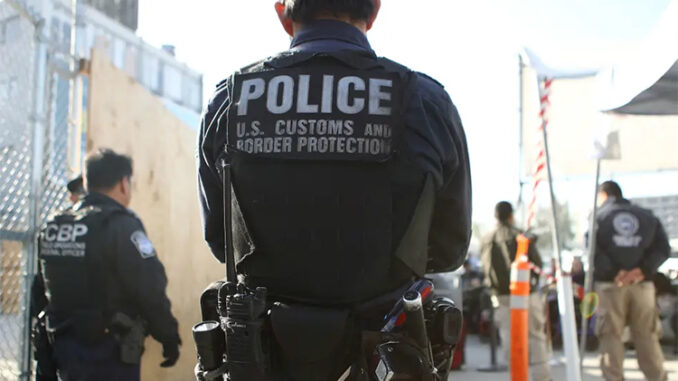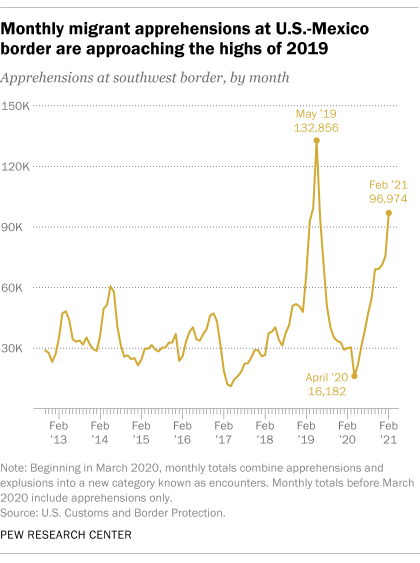
The U.S. Border Patrol apprehended nearly 100,000 migrants at the U.S.-Mexico border in February, the tenth consecutive month of increased apprehensions and a return to levels last seen in mid-2019.

The number of monthly apprehensions had fallen to just 16,182 in April 2020, shortly after the coronavirus pandemic forced the virtual closure of the southwestern border and slowed migration across much of the world. But apprehensions have climbed every month since then and reached 96,974 in February, according to new data from U.S. Customs and Border Protection (CBP), the federal agency that encompasses the Border Patrol. (It’s important to note that apprehensions refer to events, not people, and some migrants may be apprehended more than once.)
February’s apprehension total was far higher than the typical monthly figure in recent years, with the exception of a dramatic rise in 2019 during the administration of President Donald Trump. The Trump administration responded to the increased border activity with a series of new restrictions intended to deter migrants from traveling to the United States to seek asylum. Those policy changes included the “Remain in Mexico” program, which required asylum seekers to wait in Mexico until their claims could be heard. How we did this
President Joe Biden has begun to reverse some of Trump’s immigration restrictions, including the Remain in Mexico policy. That has led some Republicans to blame Biden’s approach for the latest rise in migration, even as White House officials have cautioned migrants against making the journey. Experts have pointed to other possible factors behind the growing number of migrants apprehended at the border, including the widespread economic damage caused by the pandemic and natural disasters in Central America, the origin region for many U.S.-bound migrants.
While the number of monthly apprehensions at the U.S.-Mexico border is approaching the levels of two years ago, the profile of those being apprehended is very different, according to the CBP data.
Mexican migrants are accounting for a greater share of apprehensions than in the recent past, while Central Americans represent a smaller proportion. Around four-in-ten (42%) of those apprehended at the southwestern border in February were people of Mexican origin, up from 13% in May 2019, the most recent peak month for monthly apprehensions. People from El Salvador, Guatemala and Honduras accounted for 46% of apprehensions in February, down from 78% in May 2019.

The number and share of single adults being apprehended at the border has also increased dramatically. Single adults accounted for 71% of all U.S.-Mexico border apprehensions in February, while people traveling in families and unaccompanied minors represented 20% and 10%, respectively. That stands in sharp contrast to May 2019, when people traveling in families accounted for 64% of the total and single adults and unaccompanied minors accounted for 28% and 9%, respectively.
While only around a third of all apprehensions in February were people traveling in families or unaccompanied minors, their numbers have increased sharply this year. Apprehensions of people traveling in families rose from 7,064 to 18,945, or 168%, between January and February, while apprehensions of unaccompanied minors rose from 5,694 to 9,297, or 63%.
Children pose unique challenges for the Border Patrol because they may legally only be detained in holding facilities for up to three days before being transferred to shelters. As migrant apprehensions have soared in recent months, many children have been detained longer than the three-day limit due to a lack of space at shelters.
The Biden administration announced this month that it would restart an Obama-era program allowing some Central American children to apply for admission to the U.S. from their home countries in an effort to deter them from making the journey. The administration is reportedly also trying to find room for migrant children at unused school or military facilities.



Be the first to comment